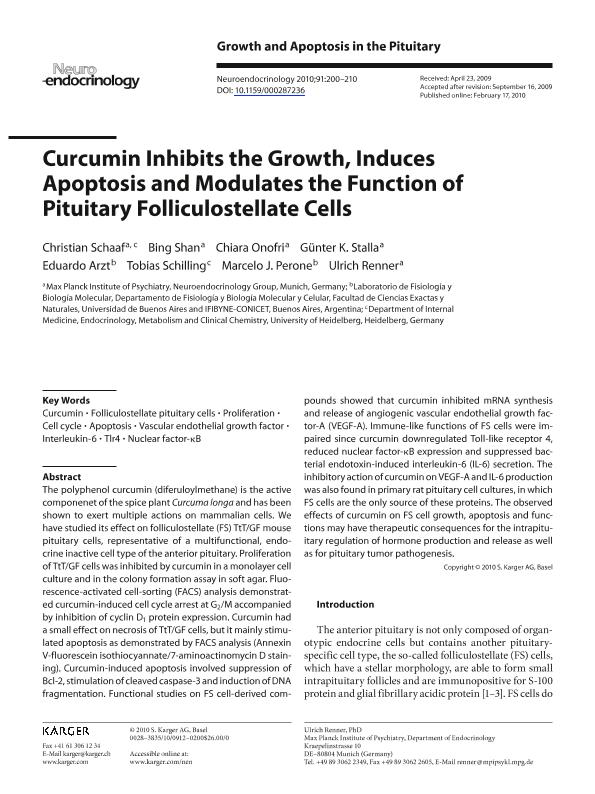Mostrar el registro sencillo del ítem
dc.contributor.author
Schaaf, Christian
dc.contributor.author
Shan, Bing
dc.contributor.author
Onofri, Chiara
dc.contributor.author
Stalla, Günter K.
dc.contributor.author
Arzt, Eduardo Simon

dc.contributor.author
Schilling, Tobias
dc.contributor.author
Perone, Marcelo Javier

dc.contributor.author
Renner, Ulrich
dc.date.available
2019-01-29T20:23:08Z
dc.date.issued
2010-03
dc.identifier.citation
Schaaf, Christian; Shan, Bing; Onofri, Chiara; Stalla, Günter K.; Arzt, Eduardo Simon; et al.; Curcumin inhibits the growth, induces apoptosis and modulates the function of pituitary folliculostellate cells; Karger; Neuroendocrinology; 91; 2; 3-2010; 200-210
dc.identifier.issn
0028-3835
dc.identifier.uri
http://hdl.handle.net/11336/68918
dc.description.abstract
The polyphenol curcumin (diferuloylmethane) is the active componenet of the spice plant Curcuma longa and has been shown to exert multiple actions on mammalian cells. We have studied its effect on folliculostellate (FS) TtT/GF mouse pituitary cells, representative of a multifunctional, endocrine inactive cell type of the anterior pituitary. Proliferation of TtT/GF cells was inhibited by curcumin in a monolayer cell culture and in the colony formation assay in soft agar. Fluorescence-activated cell-sorting (FACS) analysis demonstrated curcumin-induced cell cycle arrest at G2/M accompanied by inhibition of cyclin D1 protein expression. Curcumin had a small effect on necrosis of TtT/GF cells, but it mainly stimulated apoptosis as demonstrated by FACS analysis (Annexin V-fluorescein isothiocyannate/7-aminoactinomycin D staining). Curcumin-induced apoptosis involved suppression of Bcl-2, stimulation of cleaved caspase-3 and induction of DNA fragmentation. Functional studies on FS cell-derived compounds showed that curcumin inhibited mRNA synthesis and release of angiogenic vascular endothelial growth factor-A (VEGF-A). Immune-like functions of FS cells were impaired since curcumin downregulated Toll-like receptor 4, reduced nuclear factor-κB expression and suppressed bacterial endotoxin-induced interleukin-6 (IL-6) secretion. The inhibitory action of curcumin on VEGF-A and IL-6 production was also found in primary rat pituitary cell cultures, in which FS cells are the only source of these proteins. The observed effects of curcumin on FS cell growth, apoptosis and functions may have therapeutic consequences for the intrapituitary regulation of hormone production and release as well as for pituitary tumor pathogenesis.
dc.format
application/pdf
dc.language.iso
eng
dc.publisher
Karger

dc.rights
info:eu-repo/semantics/openAccess
dc.rights.uri
https://creativecommons.org/licenses/by-nc-sa/2.5/ar/
dc.subject
Apoptosis
dc.subject
Cell Cycle
dc.subject
Curcumin
dc.subject
Folliculostellate Pituitary Cells
dc.subject
Interleukin-6
dc.subject
Nuclear Factor-ΚB
dc.subject
Proliferation
dc.subject
Tlr4
dc.subject
Vascular Endothelial Growth Factor
dc.subject.classification
Otras Medicina Básica

dc.subject.classification
Medicina Básica

dc.subject.classification
CIENCIAS MÉDICAS Y DE LA SALUD

dc.title
Curcumin inhibits the growth, induces apoptosis and modulates the function of pituitary folliculostellate cells
dc.type
info:eu-repo/semantics/article
dc.type
info:ar-repo/semantics/artículo
dc.type
info:eu-repo/semantics/publishedVersion
dc.date.updated
2019-01-29T18:08:47Z
dc.journal.volume
91
dc.journal.number
2
dc.journal.pagination
200-210
dc.journal.pais
Suiza

dc.journal.ciudad
Basilea
dc.description.fil
Fil: Schaaf, Christian. University of Heidelberg; Alemania. Max Planck Institute of Psychiatry; Alemania
dc.description.fil
Fil: Shan, Bing. Max Planck Institute of Psychiatry; Alemania
dc.description.fil
Fil: Onofri, Chiara. Max Planck Institute of Psychiatry; Alemania
dc.description.fil
Fil: Stalla, Günter K.. Max Planck Institute of Psychiatry; Alemania
dc.description.fil
Fil: Arzt, Eduardo Simon. Consejo Nacional de Investigaciones Científicas y Técnicas. Oficina de Coordinación Administrativa Ciudad Universitaria. Instituto de Fisiología, Biología Molecular y Neurociencias. Universidad de Buenos Aires. Facultad de Ciencias Exactas y Naturales. Instituto de Fisiología, Biología Molecular y Neurociencias; Argentina
dc.description.fil
Fil: Schilling, Tobias. University of Heidelberg; Alemania
dc.description.fil
Fil: Perone, Marcelo Javier. Consejo Nacional de Investigaciones Científicas y Técnicas. Oficina de Coordinación Administrativa Ciudad Universitaria. Instituto de Fisiología, Biología Molecular y Neurociencias. Universidad de Buenos Aires. Facultad de Ciencias Exactas y Naturales. Instituto de Fisiología, Biología Molecular y Neurociencias; Argentina
dc.description.fil
Fil: Renner, Ulrich. Max Planck Institute of Psychiatry; Alemania
dc.journal.title
Neuroendocrinology

dc.relation.alternativeid
info:eu-repo/semantics/altIdentifier/doi/http://dx.doi.org/10.1159/000287236
dc.relation.alternativeid
info:eu-repo/semantics/altIdentifier/url/https://www.karger.com/Article/Abstract/287236
Archivos asociados
